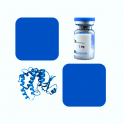
- Remove this product from my favorite's list.
- Add this product to my list of favorites.
Products
Newsletter
 |  |  |  |  |  |

Background
Glypican 1 has been shown to interact with SLIT2. This protein is involved in the misfolding of normal prion proteins in the cell membrane to the infectious prion form. Cell surface heparan sulfate proteoglycans are composed of a membrane-associated protein core substituted with a variable number of heparan sulfate chains. Members of the glypican-related integral membrane proteoglycan family (GRIPS) contain a core protein anchored to the cytoplasmic membrane via a glycosyl phosphatidylinositol linkage. These proteins may play a role in the control of cell division and growth regulation.
Source
Recombinant Mouse Glypican 1, His Tag (GP1-M52H7) is expressed from human 293 cells (HEK293). It contains AA Asp 24 - Ser 529 (Accession # Q9QZF2-1).
Predicted N-terminus: Asp 24
Molecular Characterization
This protein carries a polyhistidine tag at the C-terminus.
The protein has a calculated MW of 57.5 kDa. The protein migrates as 60 kDa under reducing (R) condition (SDS-PAGE) due to glycosylation.
Endotoxin
Less than 1.0 EU per μg by the LAL method.
Purity
>90% as determined by SDS-PAGE.
Formulation
Lyophilized from 0.22 μm filtered solution in 50 mM Tris, 150 mM NaCl, pH7.5. Normally trehalose is added as protectant before lyophilization.
Reconstitution
Please see Certificate of Analysis for specific instructions.
For best performance, we strongly recommend you to follow the reconstitution protocol provided in the CoA.
Storage
For long term storage, the product should be stored at lyophilized state at -20°C or lower.
Please avoid repeated freeze-thaw cycles.
This product is stable after storage at:
-20°C to -70°C for 12 months in lyophilized state;
-70°C for 3 months under sterile conditions after reconstitution.
Bioactivity
Please refer to product data sheet.
(1) "Human VH-based chimeric antigen receptor T cells targeting glypican 3 eliminate tumors in preclinical models of HCC"
Kolluri, Li, Li et al
Hepatol Commun (2023) 7 (2), e0022
(2) "A novel risk model based on the correlation between the expression of basement membrane genes and immune infiltration to predict the invasiveness of pituitary adenomas"
Chen, Sun, Kang et al
Front Endocrinol (Lausanne) (2022) 13, 1079777
(3) "A clinically feasible circulating tumor cell sorting system for monitoring the progression of advanced hepatocellular carcinoma"
Huang, Li, Li et al
J Nanobiotechnology (2023) 21 (1), 25
Showing 1-3 of 1553 papers.
Follow us